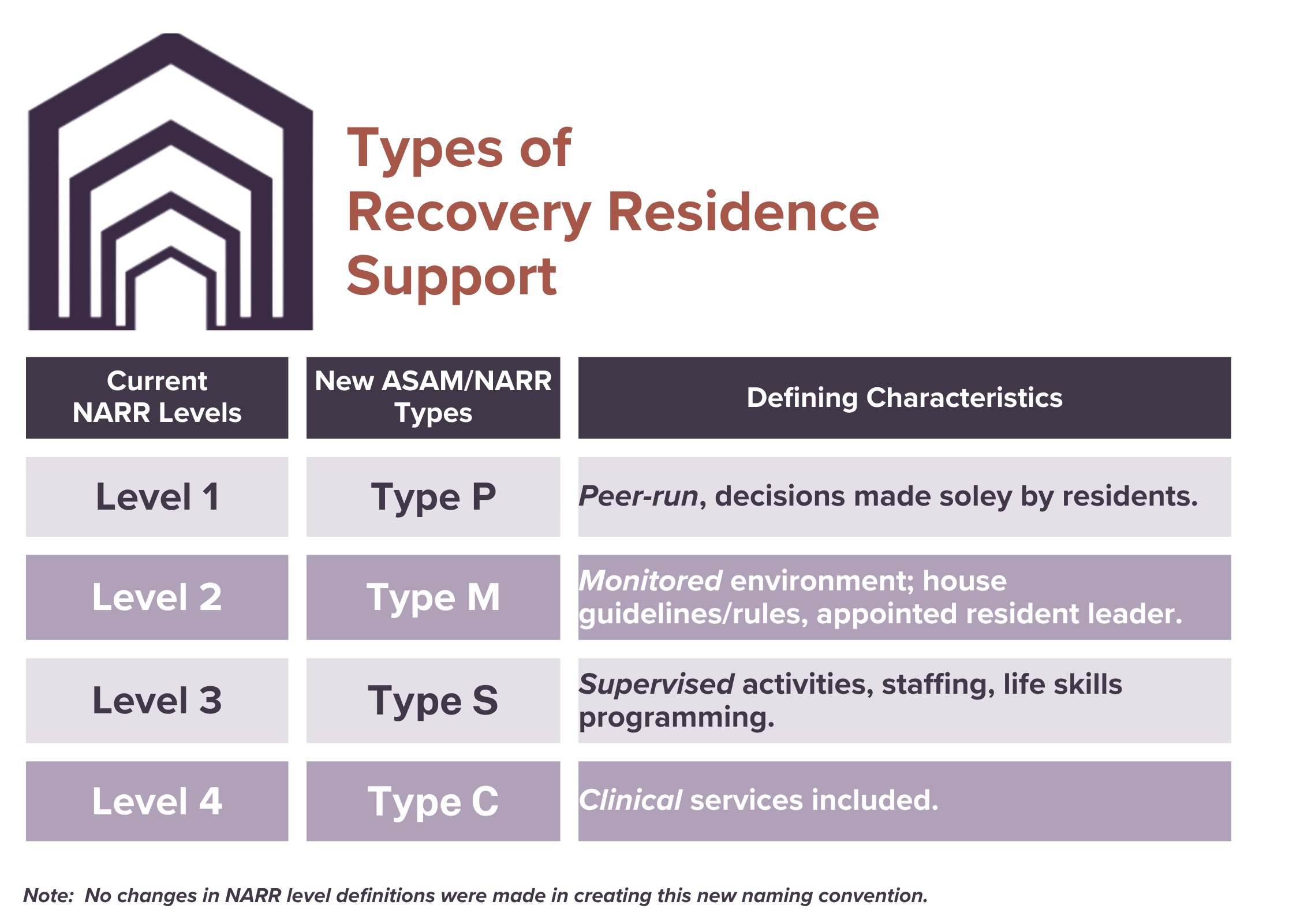The NARR Standard
Recovery residences provide safe and healthy community-oriented home environments where skills vital for sustaining recovery are practiced within a community-oriented setting. The group experience within the home fosters a culture of recovery based on shared lived experience, support, and structure - this community-based approach is referred to as the Social Model and is the basis of the national Standard for recovery residences.
The Standard defines the spectrum of recovery-oriented housing and services and distinguishes four residence types referred to as “levels” or “levels of support.” The Standard was developed with input from major regional and national recovery housing organizations, recovery residence providers from across the nation representing all four levels of support, and nationally recognized recovery support stakeholders. The NARR Standard provides guidance for certifying effective recovery residences and incorporates the collaborative values of acute care and social models of recovery. The Standard is built on the lived experience of operators and residents, not the decisions of an external accreditation body. Resident wellness and opportunities to enhance recovery are at the forefront of the Standard.

Code of Ethics
All persons working in NARR affiliate organizations, (recovery residence owners, operators, staff, and volunteers) are expected to adhere to a common NARR Code of Ethics. It is the obligation of all recovery residence owners/operators and staff to value and respect each resident and to put each individual’s recovery and needs at the forefront of all decision making.

Levels (Types) of Recovery Residences
Recovery Residence Levels define the range of recovery housing. All recovery residences offer alcohol and illicit substance-free living environments and utilize a social model recovery approach. They are differentiated by the intensity of staffing, governance, and recovery support services. NARR Levels are informed by the American Society of Addiction Medicine (ASAM) categorization of different types of treatment and recovery programs, and the terms Levels and Types can be used interchangeably.

Level I Type P (Peer-run) are democratically run alcohol and illicit substance-free recovery homes. Oxford Houses™ are the most widely known example and researched as indicated by their inclusion in SAMHSA’s National Registry of Evidence-based Programs and Practices (Substance Abuse and Mental Health Services Administration 2023). Level I recovery residences maintain a recovery-supportive culture and community using house guidelines and peer accountability. The key characteristic of a Level I is that they are democratically governed.
Level II Type M (Monitored) are frequently called sober homes or sober living. They are alcohol and illicit substance-free recovery housing that utilize house rules and peer accountability to maintain safe and healthy living environments. Senior residents, appointed by the owner/operator to serve as the head of household, are typically called the House Manager. To serve higher needs/lower recovery capital populations, such as transition aged youth (e.g., youth 16-25 years of age) with opioid use disorders, some Level II’s provide recovery support services and life skills development but at a lower intensity than Level III’s.
Level III / Type S (Supervised) delivers weekly, structured programming including peer-based and other recovery support services (e.g. recovery and resiliency groups or person-driven recovery plans) and life skills development programming (e.g., job readiness or budgeting). Staff are supervised, trained, or credentialed and are often graduates of a recovery residence. Level III’s are designed to support populations who need more intense support in developing recovery capital than provided by Level I or Level II. Level III’s are required to be licensed in a few states, reflecting the therapeutic nature of the services provided.
Level IV Type C (Clinical) integrates the social and medical model typically using a combination of supervised peer and professional staff. In addition to peer-based recovery support, recovery support services, and life skills development, Level IV's offer clinical addiction treatment. While all Level IV residence programs incorporate clinical treatment services, treatment programs lacking essential social model organizing principles would not qualify as Level IV recovery residences. Throughout the 1990s, many treatment programs discontinued their social model elements, a distinct departure from today’s residential community approach. An example of a Level IV is a recovery residence that implements social model care in a therapeutic community.
One size does not fit all; different tools and techniques are useful with different people with various severities of challenges. Participants in recovery residences can explore many recovery attitudes and associated pathways by having multiple peers who model a variety of recovery behaviors.
Why These Standards?
The mission of NARR is to support persons in recovery from addiction by improving their access to quality recovery residences through standards, support services, government and private sector collaboration, education, research, and advocacy. Recovery residences are important assets within a community and among recovery-oriented systems of services. Residences that meet and maintain the NARR Standard ensure that this resource continues as a viable asset for the people who need it. Adherence to the NARR Standard preserves the fidelity of this unique resource. Further, certified residences promote a level of consistency across houses that has not been previously seen or understood by communities, decision-makers, funders, and researchers. The consistency of core elements across certified residences can provide peace of mind to residents, families, neighbors, legislators, and funders, without additional oversight.
Discover More
Learn more about the NARR Standard and Best Practices by exploring our free Resource Library.


What is the Social (Experiential) Model?
The heart of all recovery residences is the Social Model, an operational framework that distinguishes these environments from other shared living spaces. This model emphasizes the importance of personal and collective responsibility for the safety and progressive health of oneself and others in the community. Strengths-based lived experience, peer leadership, participative governance, and community-based support networks are the foundational elements for lasting recovery.
The Social Model Philosophy Scale’s (SMPS; Room & Kaskutas, 1997) 33 items measures staff and/or resident views of a program's adherence to the social model principles across six essential domains:
Physical Environment: Assesses how well the space provides a comforting, home-like atmosphere thereby promoting a connection to and responsibility for recovery on the site.
Staff Role: Considers staff as recovery role models and mentors who encourage residents to take responsibility for their own recovery and the maintenance of their environment.
Authority Base: Emphasizes the prized value of lived experience and knowledge gained through personal recovery that often includes previous participation in the sites or similar recovery residence programs.
Recovery Orientation: Focuses on understanding alcohol and other drug use as a health issue and encourages a whole-person approach that values engagement in culturally congruent support groups and social networks.
Governance: Measures the degree to which residents have a voice in decision-making while taking responsibility for the safety and health of their environment.
Community Orientation: Assesses the engagement with and contribution to the broader recovery community for reciprocal and sustained support.
This scale promotes developing an environment of empathy, empowerment, and inclusivity that is vital for nurturing pathways of sustained recovery.